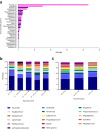An observational study of anaerobic bacteria in cystic fibrosis lung using culture dependant and independent approaches
- PMID: 33767218
- PMCID: PMC7994387
- DOI: 10.1038/s41598-021-85592-w
An observational study of anaerobic bacteria in cystic fibrosis lung using culture dependant and independent approaches
Abstract
Strict anaerobes are undeniably important residents of the cystic fibrosis (CF) lung but are still unknowns. The main objectives of this study were to describe anaerobic bacteria diversity in CF airway microbiota and to evaluate the association with lung function. An observational study was conducted during eight months. A hundred and one patients were enrolled in the study, and 150 sputum samples were collected using a sterile sample kit designed to preserve anaerobic conditions. An extended-culture approach on 112 sputa and a molecular approach (quantitative PCR targeting three of the main anaerobic genera in CF lung: Prevotella, Veillonella, and Fusobacterium) on 141 sputa were developed. On culture, 91.1% of sputa were positive for at least one anaerobic bacterial species, with an average of six anaerobic species detected per sputum. Thirty-one anaerobic genera and 69 species were found, which is the largest anaerobe diversity ever reported in CF lungs. Better lung function (defined as Forced Expiratory Volume in one second > 70%) was significantly associated with higher quantification of Veillonella. These results raise the question of the potential impact of anaerobes on lung function.
Conflict of interest statement
The authors declare no competing interests.
Figures


References
Publication types
MeSH terms
LinkOut - more resources
Full Text Sources
Other Literature Sources
Medical

